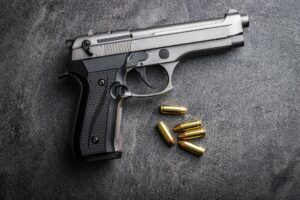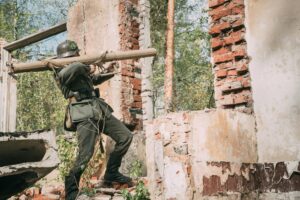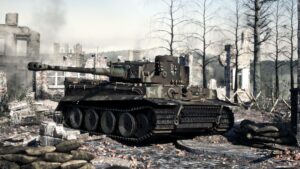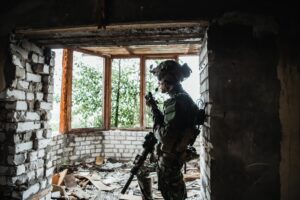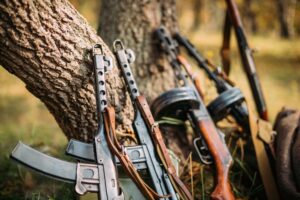The automatic Rifle G3A3, cal. 7.62 mm x 51 NATO is a modern combat rifle combining the accuracy of a sniper rifle with the firepower of a machine gun. It is produced in accordance with the most advanced manufacturing methods.
Technical Data
| Calibre | 7.62mm x 51 NATO |
| Magazine | 20 round, box magazine |
| Type of fire | Semi automatic and fully automatic |
| Rate of fire | 500-600 RPM |
| Muzzle velocity | 780-800 metre/sec |
| Muzzle energy | 3000 NM |
Sight
| Rear | Rotary rear sight with 4 adjustments 100m ‘V’ sight and 200, 300 & 400m aperture sights, adjustable for windage and elevation. |
| Front | Fixed hooded post front sight |
Length of Standard Weapons
| G3A3 | 1,025 mm |
| G3P4 | 840 mm (Butt retracted) 1,020 mm (Butt extended) |
| Barrel length | 450 mm |
| Width of weapon | 45 mm |
| Height of weapon | 210 mm |
Weight of Weapon without magazine
| G3A3 | 4.40 kg |
| G3P4 | 4.70 kg |
| Barrel grooves | 4 grooves right hand twist 305 mm lead |
| Effective Range | 400 M |
Origin
The origin of this rifle can be traced back to the final years of World War II when Mauser engineers at the Light Weapon Development Group (Abteilung 37) at Oberndorf am Neckar designed the Maschinenkarabiner Gerät 06 (MKb Gerät 06, “machine carbine device 06”) prototype assault rifle chambered for the intermediate 7.92×33mm Kurz cartridge, first with the Gerät 06 model using a roller-locked short recoil mechanism originally adapted from the MG 42 machine gun but with a fixed barrel and conventional gas-actuated piston rod.[3] With careful attention to the mechanical ratios, the gas system could be omitted.[4] The resultant weapon, Gerät 06H (the “H” suffix is an abbreviation for halbverriegelt – “half-locked”) was assigned the designation StG 45(M) (Sturmgewehr 45(M) , assault rifle 45) but was not produced in significant numbers and the war ended before the first production rifles were completed.[5]
The German technicians involved in developing the StG 45(M) were taken to work in France at Centre d’Etudes et d’Armement de Mulhouse (CEAM). The StG 45(M) mechanism was modified by Ludwig Vorgrimler and Theodor Löffler at the Mulhouse facility between 1946 and 1949. Three versions were made, chambered in .30 Carbine, 7.92×33 mm Kurz, and the experimental 7.65×35 mm French short cartridge developed by Cartoucherie de Valence in 1948. A 7.5×38 mm cartridge using a partial aluminium bullet was abandoned in 1947. Löffler’s design, designated Carabine Mitrailleuse Modèle 1950, was retained for trials among 12 different prototypes designed by CEAM, MAC, and MAS. Engaged in the Indochina War and being the second[clarification needed] NATO contributor, France canceled the adoption of these new weapons for financial reasons.
In 1950, Vorgrimler moved to Spain where he created the LV-50 rifle chambered for the Kurz cartridge and later, the proprietary 7.92×40mm CETME M53 round.[6] At this point, the rifle was renamed the Modelo 2. The Modelo 2 drew the attention of the West German Bundesgrenzschutz (Border Guards), who sought to re-equip the newly formed national defense forces. Not willing to accept a cartridge outside of the NATO specification, the Germans asked CETME to develop a 7.62×51mm version of the rifle. The resulting CETME Model A was chambered for the 7.62×51mm CETME cartridge which was identical in chamber dimensions but had a reduced-power load compared to the 7.62×51mm NATO round. Further development of the rifle with input from H&K produced the CETME Model B which received several modifications, including the ability to fire from a closed bolt in both semi-automatic and automatic firing modes, a new perforated sheet metal handguard (the folding bipod had been the foregrip in previous models), improved ergonomics and a slightly longer barrel with a 22 mm rifle grenade launcher guide. In 1958, this rifle was accepted into service with the Spanish Army as the Modelo 58, using the 7.62×51mm CETME round.
In 1956, the Bundesgrenzschutz canceled their planned procurement of the CETME rifles, adopting the Belgian-made FN FAL as the Gewehr 1 instead. However, the newly formed West German Army (Bundeswehr) now showed interest and soon purchased a number of CETME rifles (7.62×51mm NATO chambering) for further testing. The CETME, known as the Automatisches Gewehr G3 according to German nomenclature, competed successfully against the Swiss SIG SG 510 (G2) and the American AR-10 (G4) to replace the previously favored G1 rifle. In 1956 the Bundeswehr started extended troop trials with 400 CETME rifles. Heckler & Koch made a number of changes to the CETME rifles. In January 1959, the Bundeswehr officially adopted the technically improved CETME proposal.[7] The West German government wanted the G3 rifle to be produced under license in Germany; purchase of the G1 had previously fallen through over FN’s refusal to grant such a license. In the case of the G3, the Dutch firm Nederlandse Wapen en Munitiefabriek (NWM) held production and sales rights to the CETME design outside of Spain. To acquire production rights, the West German government offered NWM contracts to supply the German Air Force (Luftwaffe) with 20mm ammunition. Production of the G3 was then assigned to Rheinmetall and H&K. The latter company already had ties to CETME, and had worked to further optimize the CETME rifle for use with the full-power 7.62×51mm NATO cartridge (as opposed to the downgraded CETME variant). In 1969, Rheinmetall gave up production rights to the G3 in exchange for H&K’s promise not to bid on MG 3 machine gun production. Later in 1977, the West German government ceded ownership of G3 production and sales rights exclusively to Heckler & Koch.
Initial production G3 rifles differed substantially from more recent models; early rifles featured closed-type mechanical flip-up sights (with two apertures), a lightweight folding bipod, a stamped sheet steel handguard, a wooden buttstock (in fixed stock models) or a telescopic metal stock.[6] Before delivery to the Bundeswehr, each G3 went through functional checks, zeroing the sight line (Anschießen) and a shooting test at the factory. In the process, five shots were fired at a target at 100 metres (109 yd) with particularly accurate sighting-in ammunition. The 5-shot group could not exceed 120 mm (4.7 in) (1.2 mil/4.13 MOA) diameter. The weapon was modernized during its service life (among other minor modifications it received new sights, a different flash suppressor, and a synthetic handguard and shoulder stock), resulting in the most recent production models, the G3A3 (with a fixed polymer stock) and the G3A4 (telescoping metal stock). The rifle proved successful in the export market, being adopted by the armed forces of over 40 countries.[6] Of that figure, 18 countries undertook domestic production of the G3 under license.[8] Known manufacturers of the weapon included France (MAS), Greece (Hellenic Arms Industry), Iran (Defense Industries Organization), Luxembourg (Luxemburg Defense Technologie), Mexico, Myanmar, Norway (Kongsberg Våpenfabrikk), Pakistan (Pakistan Ordnance Factories), Portugal (FBP), Saudi Arabia (Military Industries Corporation (Saudi Arabia)), Sweden (Husqvarna Vapenfabrik AB and FFV Carl-Gustaf in Eskilstuna), Thailand, Turkey (MKEK) and the United Kingdom (Royal Ordnance).[6]
The Bundeswehr was working on improving their G3 rifles in the 1990s with a brass deflector that deflects spent cartridge cases down and frontwards from the operator and a new polymer pistol-grip/fire-control assembly module that allows better ambidextrous operation of the safety lever when they had their G3 rifles replaced for the Heckler & Koch G36. Currently (2018) hundreds of thousands of G3A3A1, G3A4A1 and G3KA4A1 modernized variants rifles are maintained by Bundeswehr personnel and kept in reserve or are available in military base small arms storages.
Design details
Operating mechanism
The G3 is a selective-fire automatic weapon that employs a roller-delayed blowback operating system. The two-piece bolt assembly consists of a breech (bolt head) and bolt carrier. The bolt is held in battery by two sliding cylindrical rollers that engage locking recesses in the barrel extension. The breech is opened when both rollers are compressed inward against camming surfaces driven by the rearward pressure of the expanding gases upon the bolt head. As the rollers move inward, recoil energy is transferred to the locking piece and bolt carrier which begin to withdraw while the bolt head slowly moves rearward in relation to the bolt carrier. As the bolt carrier clears the rollers, pressure in the bore drops to a safe level, the bolt head is caught by the bolt carrier and moves to the rear as one unit, continuing the operating cycle. Based on the geometric relationship arising from the angles of the roller contact surfaces of the locking piece and the barrel extension recesses, the recoil of the bolt head is delayed by a ratio of 4:1 for the 7.62×51mm NATO chambering. Thus during the same period of time, the bolt head carrier moves 4 times faster than the bolt head. This ratio is continued until the locking rollers have been withdrawn from the barrel extension recesses. The bolt features an anti-bounce mechanism that prevents the bolt from bouncing off the barrel’s breech surface. The “bolt head locking lever” is a spring-loaded claw mounted on the bolt carrier that grabs the bolt head as the bolt carrier group goes into battery. The lever essentially ratchets into place with friction, providing enough resistance to being re-opened that the bolt carrier does not rebound. The spring-powered claw extractor is also contained inside the bolt while the lever ejector is located inside the trigger housing (actuated by the recoiling bolt).[6]
Features
The G3 is a modular weapon system. Its butt-stock, fore-stock and pistol-grip/fire-control assembly may be changed at will in a variety of configurations (listed below). Simple push-pins hold the components in place and removing them will allow the user to remove and replace parts rapidly. The weapon made extensive use of cost-saving pressed and stamped steel components rather than machined parts and spot welding to connect parts. The stamped sheet metal cocking handle tube and receiver are large exposed parts that are prone to deformation from hard impact as they were designed to be relatively thin to save weight. If dented severely or deep enough during field service reliability problems due to internal parts movement impairments can occur that put the rifle out of action and can not be field solved by the user. To determine and correct such situations armorers are trained to employ specially designed “GO” and symmetry gauges and straightening mandrels to fairly quickly repair such problems.[9][10]
Trigger
The rifle is hammer fired and has a trigger mechanism with a 3-position fire selector switch that is also the manual safety toggle that secures the weapon from accidentally discharging (fire selector in the “E” or “1” position – single fire mode (Einzelfeuer), “F” or “20” – automatic fire (Feuerstoß), “S” or “0” – weapon is safe (Sicher), trigger disabled mechanically). The weapon can be fitted with an optional four-position safety/fire selector group illustrated with pictograms with an ambidextrous selector lever. The additional, fourth selector setting enables a three-round burst mode of fire.[6] The rifle has a relatively high trigger pull of 50–55 N (11.2–12.4 lbf) due to a drop safety requirement. An interchangeable set-trigger pack assembly featuring a trigger stop and less trigger pull is available for the G3SG/1 and other sniping orientated variants.
Sights
The original G3 and G3A1 rifle variants had a relatively low iron sight line that consisted of a Klappvisier a “L-type” flip up rear sight and hooded front post. From the G3A2 variant the firearm is equipped with a relatively low iron sight line that consists of a Drehvisier a rotary rear drum and hooded front post. The rear sight is mechanically adjustable for both windage and elevation with the help of tools. This deliberately prevents non-armorers to (re)zero the iron sight line. The rotary drum features an open V-notch (numbered 1) for rapid target acquisition, close range, low light and impaired visibility use and three apertures (numbered 2, 3 and 4) used for: 200–400 metres (219–437 yd) in 100 metres (109 yd) increments for more precise aiming.[6] The 1 V-notch and 2 or 200 metres (219 yd) aperture settings have an identical point of aim. The V-notch and apertures are calibrated for US M80 / German DM111 series or other equivalent 9.5 grams (147 gr) 7.62×51mm NATO ball ammunition. The receiver housing has recesses that work with STANAG claw mounts/HK clamp adapters used to mount day or night aiming optics.
Barrel
The rifled barrel – four right-hand grooves with a 305 mm (12.0 in) twist rate – terminates with a slotted flash suppressor which can also be used to attach a bayonet or serve as an adapter for launching rifle grenades. From the G3A3 the barrel was free floated from the stock and had polygonal rifling.[11] The barrel chamber is fluted with twelve flutes, which assists in the initial extraction of a spent cartridge casing (since the breech is opened under very high barrel in internal cartridge case pressure).[6]
Feeding
The G3A3 (A4) uses either steel (260 g) or aluminium (140 g) 20-round double-stacked straight box magazines, or a 50-round drum magazine. H&K developed a prototype plastic disposable magazine in the early 1960s, but it was not adopted as aluminum magazines were just as light and proved more durable, as well as easier to produce.
Accessories
Standard accessories supplied with the rifle include: a detachable bipod (not included with rifles that have a perforated plastic handguard), sling, cleaning kit and a speed-loading device. Several types of bayonet are available for the G3, but with few exceptions they require an adapter to be inserted into the end of the cocking tube. The most common type features a 63⁄4 inch spear-point blade nearly identical with the M7 bayonet, but with a different grip because of its mounting above the barrel. The weapon can also mount a 40 mm HK79 under-barrel grenade launcher, blank firing adapter, a straight blowback bolt (called a “PT” bolt, lacks rollers) used for firing 7.62×51mm ammunition with plastic bullets, a conversion kit used for training with .22 Long Rifle ammunition and a sound suppressor (that uses standard ammunition).
Variants
The G3 served as a basis for many other weapons, among them: the PSG1 and MSG90 precision rifles, the HK11 and HK21 family of light machine guns, a semi-automatic version known as the HK41, a “sporterized” model called the SR9 (designed for the civilian market in countries where the HK91 would not qualify, primarily the US after the 1989 importation restrictions) and the MC51 carbine.
- G3: Original model based on the CETME Model 58 introduced in 1959 and approved in 1960. It had a wooden stock and handguard.
- G3A1: G3 approved in 1963 with a single-position, retractable stock sliding in grooves pressed in the sides of the body, locked by a catch under the special bodycap. This design was chosen after earlier experimentation with an MP-40 style ventrally-folding metal stock; excessive recoil caused it to be dropped from consideration.
- G3A2: G3 developed in 1962 with new rotating drum rear sight and a Freischwinger (FS) free-floating barrel that significantly improved accuracy.
- G3A3: The most well known 1963 version. Drum sights with an improved front sight, a flash-suppressor/muzzle brake capable of firing NATO standard grenades, a fixed solid plastic buttstock, and a plastic handguard that does not contact the free-floating barrel. The handguard came in a slim, ventilated version and a wide version. The latter allows for the attachment of a bipod.
- G3A3A1: This is a version of the G3A3 with an ambidextrous trigger group and brass deflector. This is an official German Army designation, not an HK factory one.
- G3A4: The G3A4 uses drum sights and a single position, retractable stock. Entered service in 1974 for frontline infantry units.
- G3A4A1: This is a variant of the G3A4 with an ambidextrous trigger group and brass deflector. This is an official German Army designation, not an HK factory one.
- G3KA4: Smallest of the line, it is a Karabiner, or carbine version of the G3. It uses an HK33 handguard, features drum sights, a retractable stock, and a 315 mm (12.4 in) barrel (reduced in length to the base of the front sight post), that is too short for use with a bayonet or rifle grenades.[6]
- G3KA4A1: Variant of the G3KA4 with a polymer grip assembly, ambidextrous trigger group and brass deflector. This is an official German Army designation, not an HK factory one.
Models made under license
The G3 rifle is or was produced under license in the following countries: Brazil, Iran, France, Greece, Norway, Mexico, Myanmar, Pakistan, Portugal, Saudi Arabia, Sweden and Turkey.
- G3P3: Model number for Pakistani-made version of G3A3.
- G3P4: Model number for Pakistani-made version of G3A4.
- G3A5: HK assigned model number for the HK-made Danish version of the G3A3. It differs in that it has a silent bolt-closure device. In Danish service it is known as the Gv M/66. The Gv M/66 was originally intended for use with optics as a designated marksman rifle, while the rest of the squad were issued M1 Garands.
- G3A6: HK assigned model number for the Iranian-made version of the G3A3. It differs in having a dark-green handguard, stock, and trigger pack.
- G3A7: HK assigned model number for the Turkish-made version of the G3A3.
- G3A7A1: HK assigned model number for the Turkish-made version of the G3A4.
- HSG1: HK assigned model number for the Luxembourg-made version of the G3A3.
- BA63: Model number for Myanmar-made version of original G3 (with wooden stock, handguard and flip sight)

















